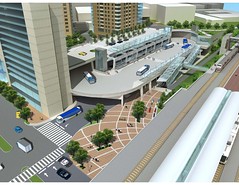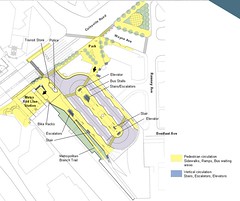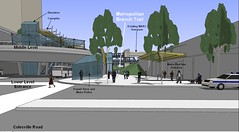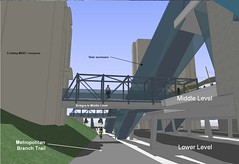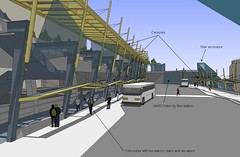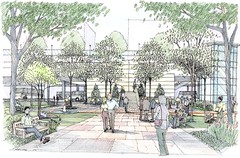|
Special Features





Image Libraries


|
|
Blog
Last year about this time I visited Seattle, Portland, and Vancouver. I prepared a slideshow of transportation photos from the three cities to share with coworkers. It’s essentially a tour of rail, bus, and bike infrastructure within each city. Why not share it here too?
Click the image to download a pdf of the slideshow. It’s about 16 Mb. If you just want to see the photos in flickr without commentary, here they are.
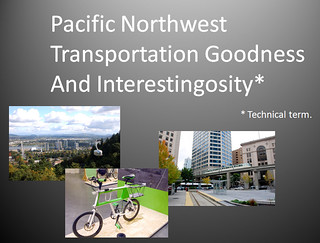
Click to download pdf.
Average Rating: 5 out of 5 based on 232 user reviews.
October 16th, 2012 | Permalink
Tags: bike, boat, BRT, bus, commuterrail, galleries, intercity, lightrail, streetcar, transportation

|
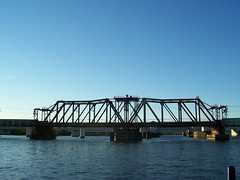
The Long Bridge. Photo by Monika & Tim via flickr. |
DC will soon kick off a new study, focused on potential replacement or expansion options for Long Bridge, the rail-only Potomac River bridge that carries Amtrak, VRE, and freight trains between DC and Virginia.
The bridge, which was originally built in 1904 and then substantially rebuilt in 1942, is a major bottleneck and capacity constraint on rail services in the region. It has only two tracks, which severely limits the number of trains that can move across the river. This study will be an opportunity to evaluate the need for more tracks, which if built could increase Amtrak and VRE service south of DC.
DDOT will also consider other modes. Would it make sense to add a bike trail to the bridge, or separate tracks for streetcars? DC and Arlington both have plans for streetcars near the river on either side of Long Bridge, so connecting them might make sense.
The study is just starting, so it will be a while before recommendations start to come out. But it’s definitely one to keep an eye on.
Average Rating: 4.4 out of 5 based on 233 user reviews.
September 12th, 2012 | Permalink
Tags: commuterrail, intercity, master planning, transportation

|

Proposed main level train room. |
Amtrak released its long range plan for Union Station yesterday. If implemented, the proposed redesign will accommodate double the train service and triple the number of passengers as compared with the existing station.
The plan looks pretty nice, and includes some beautiful features. Foremost among them is a new European-style train room that would be unprecedented in North America. Instead of boarding trains from a dim cavern below the parking garage, riders would board from a brightly-lit glass enclosure.
Despite that, I can’t help but feel a little bit nervous about the whole thing.
A hundred years ago almost every major American city had a beautiful train station. Unfortunately many were destroyed during the 20th Century. Of those that survived, the vast majority are mere shells of their former selves. Washington Union Station is one of the only exceptions. It’s an absolutely beautiful historic building that remains active, vital, and functioning as an extremely busy train station. In my opinion it’s the best intercity rail station in America.
And so when plans come forward to dramatically change it, I get a little bit worried. So many of the country’s train stations have been ruined by redevelopment, it’s clearly a dangerous business.
But Union Station does legitimately need to be expanded. It’s a bottleneck that limits all of its rail users: Amtrak, MARC, VRE, even Metro. More capacity is needed, if not today then surely by this plan’s ~2030 timeline. So more slots for more trains have to be accommodated somehow.
So Union Station must expand, but carefully. The key concern with any potential redesign must be the continued health and vitality of the historic building. Amtrak must not allow its greatest station to suffer the fate of so many of its one-time peers. Expansion is fine, but the old building must not be replaced, even in function. Supplement, but don’t take over.
Thanks to historic preservation there is no danger that Washington Union Station will be bulldozed and replaced by a modern version, as New York’s famous Penn Station was. But there might be a danger that Washington would follow the example of Denver, where that city’s Union Station will soon be converted to a hotel, and all of its rail functions moved to new buildings directly behind the old depot.
The key demand for any expansion of Union Station must be that the original building continue to function as an integral part of the depot. Most Amtrak, MARC, and VRE passengers should continue to pass through it, and the concourse facilities should be as close as possible.
It’s true that many of the rail-related functions moved out of the original building decades ago. Nevertheless, the expansions so far have resulted in a seamless whole. Casual users don’t notice where the old building ends and the new one begins. Just about everyone passes through the original depot, which still includes ticketing, and remains where most internal Union Station circulation takes place.
Any expansion must work the same way.
So how does this new plan perform?
The general premise of the plan is to basically do two things: 1) Double the number of stub-end tracks on the main level, and 2) dramatically expand the lower food court level, adding new tracks and 2 additional waiting areas further north than the current concourse.
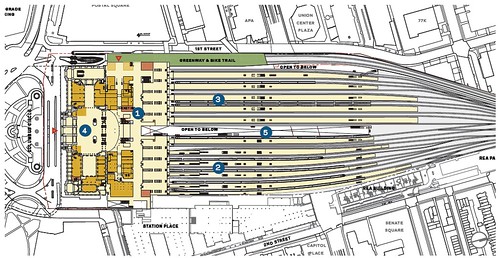
Proposed main level floor plan.

Proposed lower level floor plan, showing new concourses.
The main level concourse that was built in the 1980s will be renovated and enlarged. This is great news. It’s not a historic space, so renovating it is no loss (and will probably be a big improvement), and it is the most convenient location for a concourse to be accessed via the old building. These improvements should guarantee that the front of the building remains very important, and heavily used.
Behind the renovated front concourse, the existing train room will be replaced by a new European-style open version. This continues the existing layout, but with a vastly superior design. Thumbs up to that.
The two new lower level concourses will unfortunately serve to disperse users further away from the main building. Hopefully they will draw just enough people to remain busy themselves, but not so many that they become the new center of the station.
The middle concourse will be reserved for MARC and VRE. It does make sense to separate them from intercity traffic, so if there’s going to be a new concourse then this one makes sense.
The northernmost concourse will offer redundant access to all platforms. It’s there so users from NoMa don’t have to walk south to the main entrance and then backtrack north. As long as most of the station’s amenities remain in the front, this secondary access point will remain less convenient for most users, and therefore should not be a major problem.
The walkway connecting the two new northern concourses to the main building is called the center concourse. As the hub for two of the three boarding areas, this will surely become a busy area. It could threaten the old building’s vitality if too many rider amenities are moved from the front of the station to this walkway. The main ticket counter, for example, should remain in the old building. But as long as this walkway remains just a walkway, and does not take on the functions of a terminal, it should not be a problem.
All in all, there seems to be enough activity remaining in and near the old building to guarantee its continued use. There are lots of new things further north, but they appear to remain secondary to the front. These changes should make Union Station even better than it is now.
But I’m still a touch nervous. A lot will depend on the details of where rider amenities are located.
Here are more images from the report:
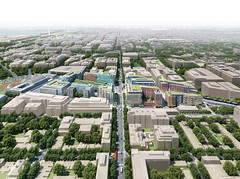
Overview of the entire development, including air-rights buildings. |

Proposed new rear entrance, leading directly to the glass-enclosed train room. |
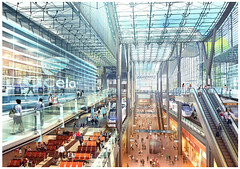
Proposed new central concourse, as seen from approximately the current concourse-to-parking garage escalator. |
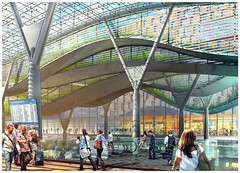
Elevators leading from one of the lower concourses up into the train room. |
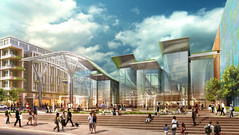
Proposed new rear entrance. |
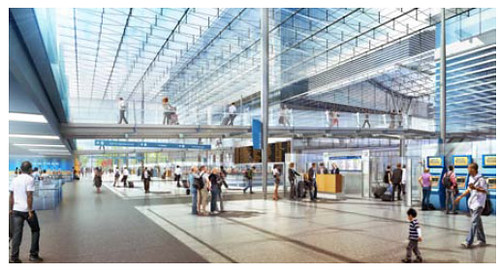
Proposed renovation to the existing stub-end concourse. |
Average Rating: 4.6 out of 5 based on 176 user reviews.
July 26th, 2012 | Permalink
Tags: architecture, commuterrail, development, galleries, intercity, preservation, transportation

For years Baltimore has lacked a consolidated rail system map. Rather, they had separate maps for the Metro-Subway, light rail, and MARC, even though all are run by the same agency. This made navigating the city’s rail system unnecessarily difficult, since users hoping to transfer between the various rail modes had to consult multiple maps.
Finally, late in 2011, a consolidated rail map for Baltimore was published. It’s not the world’s greatest example of graphic design, actually it’s quite awful from that perspective, but at least it’s functional. It is easily the most fully integrated rail system map I’ve ever seen for the city.
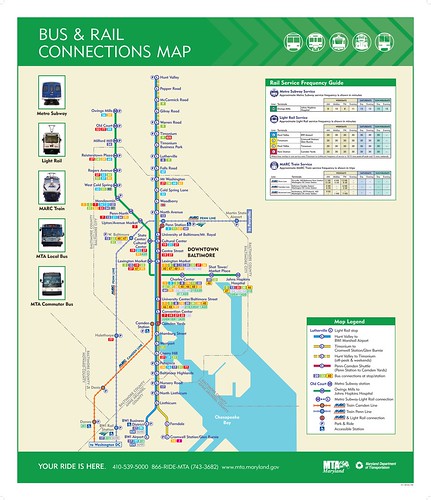
The map is one part of an entire series of new transit maps produced by MTA for the Baltimore region. There are several interesting maps in the series, including a diagrammatic bus system map (as opposed to a geographical one), and a WMATA map showing MTA bus connections.
Average Rating: 4.6 out of 5 based on 265 user reviews.
May 24th, 2012 | Permalink
Tags: commuterrail, lightrail, metrorail, transportation

It wasn’t too many years ago that transit was an afterthought in the United States. For years at a time in the latter half of the 20th Century only a handful of US cities were actively building new transit lines at any given time.
But as this map from national transit blog The Transport Politic shows, the times, they’re a-changin’.
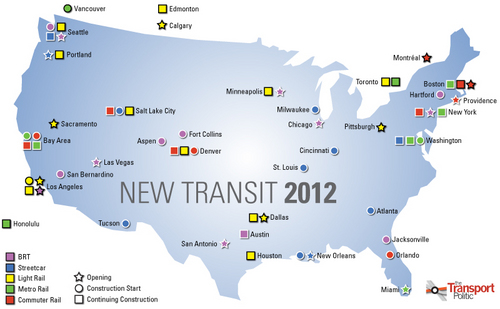
Major transit openings and construction starts planned for 2012.
Image by Yonah Freemark on The Transport Politic.
The map was published as part of an extensive post that lists every major transit line in the US that will either open or be under construction in 2012.
The list is impressive. Nearly every major metropolitan area in the country is represented, and even more would be if the list included projects in the planning stages but not yet slated to begin construction.
The listed projects range from the gargantuan to the mundane. From New York’s Second Avenue subway, to a BRT line in Fort Collins, Colorado.
The three map icons next to Washington indicate DC’s streetcar projects and the two phases of the Silver Line. Other local projects, such as the Purple Line, the Columbia Pike streetcar, and the Corridor Cities Transitway, aren’t shown because they are still in planning.
Our country still has a long way to go before the decades of automobile-focused planning are fully repaired. Even this list, impressive as it may be, is short compared to the highway construction list from most individual states. But still, we’re making progress as a country. We’re doing things now that we weren’t doing a few decades ago. Transit is reaching more people, in more places.
So let’s congratulate ourselves for a solid step forward. But let’s not be too happy; there’s still much work to be done.
 Cross-posted at Greater Greater Washington. Cross-posted at Greater Greater Washington.
Average Rating: 4.9 out of 5 based on 178 user reviews.
January 4th, 2012 | Permalink
Tags: BRT, commuterrail, lightrail, metrorail, streetcar, The New America, transportation

America’s most fun rail livery belongs to the Rail Runner, a commuter rail operation in New Mexico. Enjoy the eye candy:
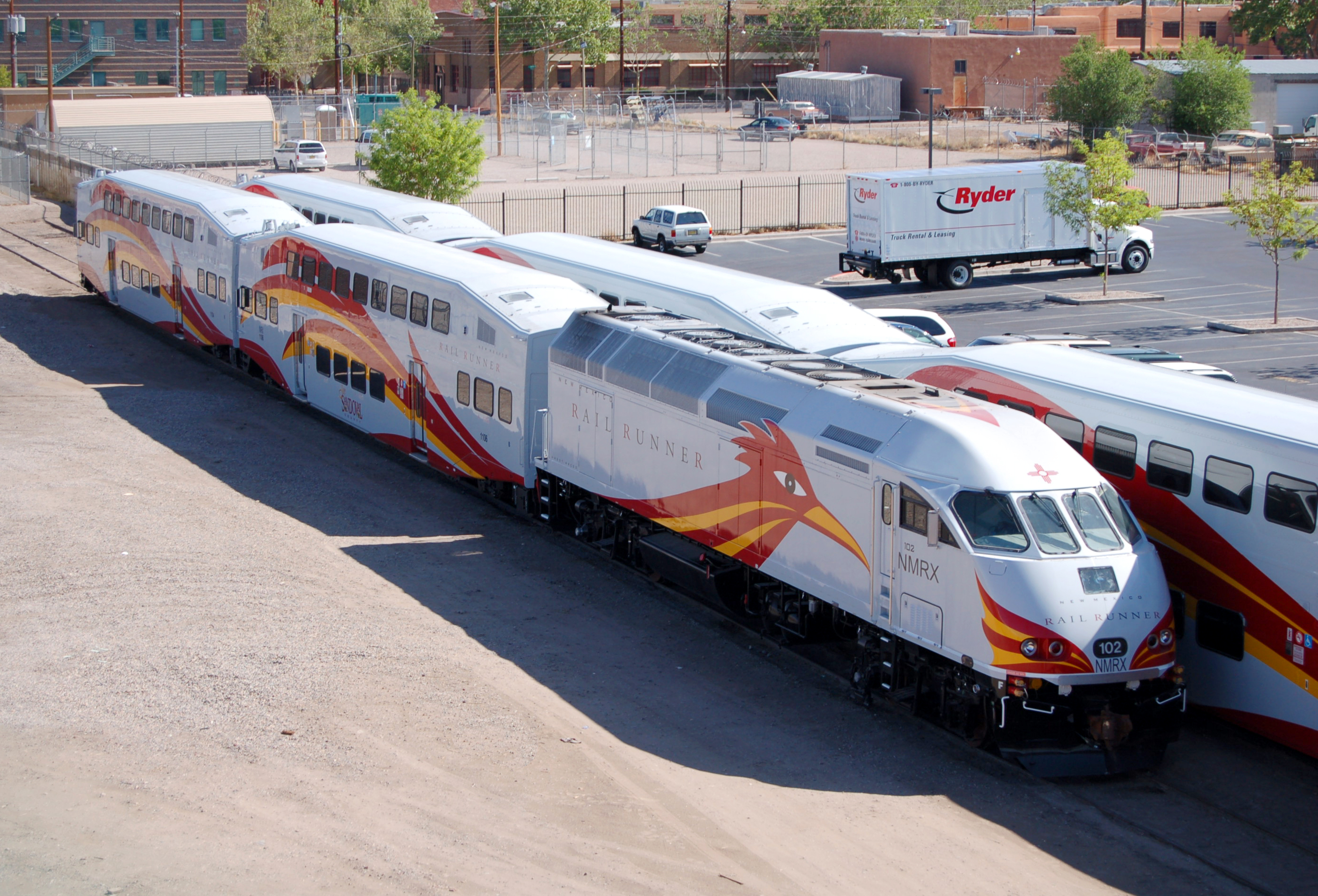
Photo from Wikipedia.
Average Rating: 4.4 out of 5 based on 258 user reviews.
September 7th, 2011 | Permalink
Tags: commuterrail, galleries, transportation

With construction well under way, Silver Spring’s new multimodal transit center is rising quickly from the ground. It seems a good time to share details of this important project.
The new center will consolidate just about every mode of transit imaginable into a single station, to be named for former US Senator Paul Sarbanes. It will include:
- 34 bus bays for use by local, commuter, and intercity buses.
- Kiss & Ride facilities for cars.
- A taxi stand.
- The Metropolitan Branch bike/ped trail.
- Bike racks (and maybe a bikesharing station, if Montgomery County joins Capital Bikeshare).
- Improved connections to the existing MARC and Metrorail platforms.
- A commuter store.
- Three major parks/plazas for civic use and passenger waiting.
Overall, Sarbanes Station will become the largest multimodal transportation depot in the Washington region, after Union Station.
Plans and renderings of the project are below, courtesy Montgomery County.
The design under construction is at least the third iteration. The previous two versions of the design were both quite different. For the sake of posterity, here they are:

The original design featured a grand stair, but didn’t leave room for the Purple Line. |
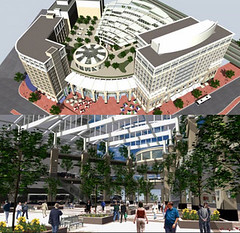
The second design was focused around a luxurious “hanging garden” waiting room. Courtesy Torti Gallas. |
 Cross-posted at Greater Greater Washington. Cross-posted at Greater Greater Washington.
Average Rating: 4.9 out of 5 based on 187 user reviews.
May 12th, 2011 | Permalink
Tags: architecture, bike, bus, commuterrail, galleries, intercity, lightrail, metrorail, transportation

|

New York’s LIRR commuter rail runs 24 hours a day, 7 days a week. VRE could too.
Photo by flickr user Schaffner. |
Northern Virginia Congressmen Gerry Connolly and Jim Moran have introduced a bill authorizing (but not allocating money) to study and conduct preliminary engineering for suburban expansions of all of Virginia’s Metrorail lines, as well as an extension of Maryland’s Purple Line light rail project into Virginia, and unspecified “Metrorail capacity expansions” throughout the region.
While it’s good news that Northern Virginia’s Congressional representation has an eye towards transit (though Frank Wolf’s absence is notable), the bill is a reminder of the fact that for many people in this region the word “transit” is one-dimensional code for Metrorail. This is unfortunate, because while Metrorail is undeniably great, it isn’t the best solution to every transit problem we face. If we could could make the intellectual jump to accept a more diverse collection of transit modes, we would have the means to provide a better and more comprehensive regional transit network, faster and for less money.
Long time readers to BeyondDC have heard this before. I bring it up from time to time because it is such an important issue that it bears repeating.
The issue is that Metrorail is much, much more expensive to build than other transit modes such as commuter rail, light rail, streetcar, and BRT. Although MetroRail extensions to Woodbridge, Fort Belvoir and Centreville might be wonderful in those individual corridors, for about the same cumulative cost we could put light rail on every major arterial street in Northern Virginia and upgrade all the VRE lines to Metro-like service levels, with trains running frequently all day and on weekends.
Basically, if we were a little more open-minded with modes, we could have a transit system that put rail stations within walking distance of almost everyone in Northern Virginia for about the same cost as a couple of Metrorail extensions.
This isn’t to suggest that our historic investments in Metrorail were wrong. They weren’t. We need the high-cost, high-capacity core system to provide the backbone of our regional transit system. But with that backbone already in place, we can now do more with other modes. Metro is fabulous and we need it, but its reach is limited because it’s so expensive that we can’t build very much of it. Light rail and dramatically enhanced commuter rail don’t suffer from that problem.
Average Rating: 4.5 out of 5 based on 201 user reviews.
January 12th, 2011 | Permalink
Tags: BRT, commuterrail, government, lightrail, metrorail, streetcar, transportation

VRE carried 19, 322 passengers on Wednesday, setting a new single day ridership record for the agency. The previous record was set in February, and all 10 of the highest days have been in 2010.
Yay! Good work, VRE.
Average Rating: 4.5 out of 5 based on 223 user reviews.
October 14th, 2010 | Permalink
Tags: commuterrail, transportation

|

Point of Rocks station |
Train stations are the perfect nexus of transit and architecture geekdom. Obviously, I love them. Since I also like to make lists, and since the DC area is fortunate enough to have several excellent examples of historic depots, here is a list of what I think are the best ones:
Number 10: Manassas
I’m a sucker for turrets and covered platforms, which help this otherwise unextraordinary station squeak in at number 10. Used by VRE and Amtrak.
Number 9: Chesapeake Beach
Click the link and look at the picture with the station all prettied up for Christmas. Isn’t that adorable? Too bad it’s no longer a functioning depot.
Number 8: Harpers Ferry
Solid all around, and it gets bonus points for being next to an awesome mountain tunnel. Used by MARC and Amtrak.
Number 7: Rockville
B&O Railroad architect Francis Baldwin designed a ton of great Victorian stations in Maryland. More will appear further down. Rockville’s is no longer in use as a depot.
Number 6: Fredericksburg
This big brick station is best remembered for its industrial looking covered platforms. We don’t have much of that steel look in DC, so it’s fun to find nearby. Used by Amtrak and VRE.
Number 5: Martinsburg
It used to be common for hotels and train stations to co-locate (especially out west). This is the only local example I know of. Used by Amtrak and MARC.
Number 4: Gaithersburg
Another of Francis Baldwin’s B&O depots, this one seems straight out of a fairy tale. Used by MARC.
Number 3: Frederick
This vintage 1854 building is reminiscent of Washington, DC’s old B&O station, which was demolished when Union Station was built. No longer in use as a depot.
Number 2: Point of Rocks
The best of Baldwin’s B&O stations, this one is just gorgeous. Used by MARC.
Number 1: Washington Union Station
Really, could there be any other answer?
Honorable Mentions: Fairfax Station, Laurel, Kensington (the latter two are Baldwin stations). Also note that I excluded the Baltimore area, which has a ton of good stations as well.
Average Rating: 4.6 out of 5 based on 269 user reviews.
October 5th, 2010 | Permalink
Tags: architecture, commuterrail, intercity, preservation, top10, transportation

|
Media





Site
About BeyondDC
Archive 2003-06
Contact
Category Tags:
Partners
|

























